By Lucien de Guise
Whether produced in a courtly or
an urban setting or for a religious context,
Islamic art is generally the work of anonymous
artists. A notable exception is in the sphere of
the arts of the book. The names of certain
calligraphers are well known, which is not
surprising given the primacy of the written word
in Islam, as are those of a number of painters,
most of whom were attached to a particular court.
The identification of these artists has been
based on signed or attributed examples of their
works and on textual references. Given the great
number of extant examples, comparatively few
signatures are found on metalwork, pottery,
carved wood and stone, and textiles. Those
signatures that do occur, combined with rare
evidence from contemporary textual sources,
suggest that families of artists, often over
several generations, specialized in a particular
medium or technique.
http://www.lacma.org/islamic_art/intro.htm
Is there a
difference between Islamic Art and Art of the
Islamic World? According to the ever fickle art
market in the West, there is. The question is
whether such definitions arise out of political
correctness or the changing viewpoints which echo
the rapidly shifting sands of the ongoing
East/West dialogue.
Muslims tend to give a lot of thought to what is
“Islamic”, unless the topic happens to
be art. Others have been giving rather more
attention to the subject. Among the most vigorous
debaters is the art market, some elements of
which have reassessed the terminology. Up until
almost a decade ago, Sotheby’s held regular
sales of what it called “Islamic art”.
Nowadays it is “Arts of the Islamic
world”.
The new approach makes life much easier for the
auction house. There are no more awkward
questions about what makes an object Islamic.
Instead, they can include anything that comes
from a part of the world that might pass for
being Islamic. Sotheby’s has, in effect,
opted out of the debate on what constitutes
Islamic art. Whether this is for convenience or
out of some form of political correctness is not
clear. Others do not appear to be following this
example. In New York, the capital of political
correctness, The Metropolitan Museum persists
with its Department of Islamic Art, as does the
British Museum. The Louvre in Paris will be doing
the same when it opens its dedicated new gallery
in four years’ time.
At London’s Victoria & Albert Museum,
2006 is the date for the re-opening of the space
that will be known as the Jameel Islamic Art
Gallery, in honour of a major benefactor. A
number of newer institutions are also happy to
use the old terminology. These include the Museum
of Islamic Art, designed by I. M. Pei, which will
open in Qatar next year, and the Islamic Arts
Museum Malaysia, which has been the Asian leader
in its field for the past six years.
It seems that the term Islamic art is going to
remain in circulation, despite disapproval from a
writer as respected as Souren Melikian-Chirvani
of the International Herald Tribune. To give an
indication of the media status accorded to
Islamic art, Souren is just about the only
authority on the subject whose views appear in
mainstream journalism. Fortunately for his
career, Souren’s expertise ranges more
widely more than his original field of study and
he can write commandingly on anything from
classical Greek ceramics to contemporary dustball
sculptures. He does not like the term Islamic
art, but with so few IHT readers taking an
interest in the subject, it is hard to push the
argument too hard.
The question that Souren and other, less-public
figures have asked is why should an object from
an Islamic land be labelled Islamic, when so few
items from “Christendom” are called
“Christian art”. Europe is still
nominally Christian, but there is little from
there that anyone would term Christian. The
closest that most modern European artists get to
a religious theme is the work of Chris Ofili,
whose image of the Madonna made from elephant
dung is generally considered blasphemous.
It has to be said that even the most
opportunistic auction houses would hesitate to
put the artistic output of contemporary Muslim
nations into
a sale of Islamic art. It is, however, common to
put the work of modern artists into sales of
“Islamic and Indian Art”.
One thing is certain: religious art of any
persuasion is usually old. Fields such as Judaica
or Buddhist artefacts do let in the occasional
new boy, but on the whole it seems to be accepted
that only works from before the 20th century have
that essential spiritual dimension. With
Christian, Hindu, Jain, Buddhist and Jewish art,
the objects that collectors seek out have a
direct religious connection. These might be a
manifestation of Vishnu or a medieval European
reliquary housing the body parts of an
unfortunate saint. For admirers of Islamic art,
the entry terms are more flexible. Just about
anything counts, whatever purpose it was made
for, and whomever it was made by. The only
serious requirement is that an item should come
from a place with an Islamic tradition. As a
result, the Islamic-art market offers 19th
century Persian paintings of topless women
alongside vessels designed to enhance the
enjoyment of alcohol. The most expensive lot to
be sold at an Islamic art auction last year was a
wine flask made for a Mughal emperor in the 17th
century.
In addition to flouting one of the most widely
known Islamic prohibitions, the flask had other
features that would appal the pious. It has
substantial quantities of gold -- discouraged for
earthly use but acceptable when a believer
reaches Paradise -- and is ornamented with a
profusion of precious stones that would also be
considered inappropriate. In the end, the export
of this Indian was halted by the British
government on the basis that it was an essential
part of UK culture. This is, in itself, an
interesting reflection on the state of cultural
patrimony issues. India did not clamour to have
it returned, and the government of Pakistan
certainly took no interest in the wine flask. Its
English credentials came from it having
originally been owned by the disgraced
18th-century adventurer Clive of India, who had
acquired it because of his love of gaudy
souvenirs rather than a specific interest in
“Islamic” art. The concept of art being
Islamic is as new in Western terms as it is among
Muslims. Until the late 19th century, an object
was collected on the basis of its quality or
aesthetic appeal. Count-less weapons from the
Islamic world were acquired by European
collectors centuries ago. These would now go
straight to the Islamic section of most museums.
The older collections of weapons were established
before everything from Islam was counted as being
Islamic. More recent collections take a different
view, partly due to the dynamics of supply and
demand. When collectors of arms and armour were a
more powerful force than Islamic-art collectors,
they were the ones who metaphorically called the
shots. Nowadays, life is harder for those who
want to move weapons around the world, or keep
them in their homes, unless they live in certain
US states. Islamic art has become a bigger field,
and less troublesome too. Most of what is for
sale comes with none of the hassles that
accompany fields where cultural-property laws are
rigorously enforced. Buyers of unprovenanced
works of Italian origin are asking for problems.
Those who take on the Greek government will
usually regret it, unless the object in question
is of Islamic interest. Greece puts considerably
more effort into reclaiming the Parthenon marbles
than it ever has with its Islamic past.
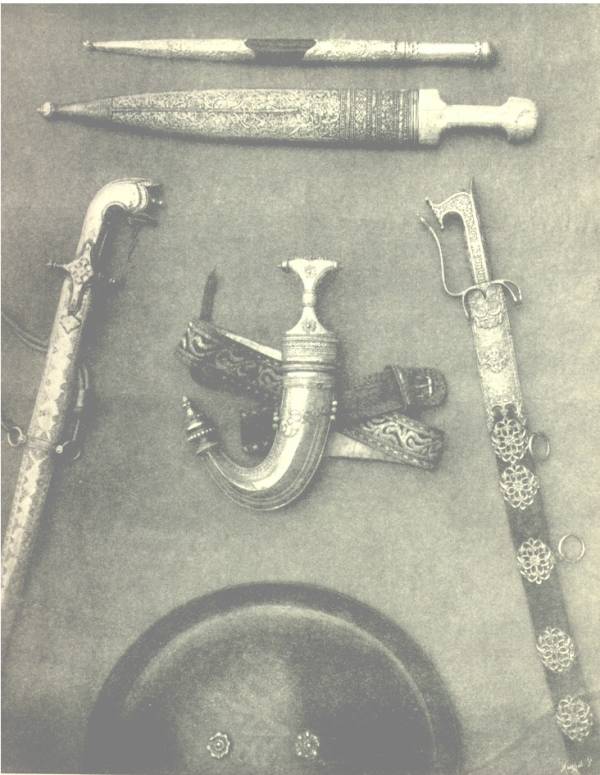
The
Islamic-art market has only been significant
money maker for a few decades. It went from being
a small circle of Western connoisseurs with
Orientalist tastes to being much more
international. Oil wealth has been the usual
driving force, although Turkey’s economic
success raised prices enormously in some areas.
The new collectors need collectables. The cream
of these items often come from countries like
Afghanistan, a powerhouse of creativity in the
past. The ease with which newly excavated or
looted works leave Afghanistan makes its heritage
more available than, say, Iraq’s, until
recent events.
A market deprived of supplies is unlikely to
provide the best definition of Islamic art. At
the same time, demand keeps growing. There are
not only new museums to stock; older institutions
have tried to respond to growing worldwide
interest in Islam. Some, like the Victoria &
Albert Museum, already have superb collections
which they would like to augment, although the
V&A declared that it was dropping out of the
race while prices remain as high as they have
become in recent years.
*********
Advanced
geometry of Islamic art
A study
of medieval Islamic art has shown some of its
geometric patterns use principles established 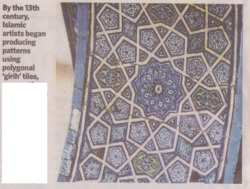 centuries later
by modern mathematicians. Researchers in the US
have found 15th Century examples that use the
concept of quasicrystalline geometry. This
indicates intuitive understanding of complex
mathematical formulae, even if the artisans had
not worked out the underlying theory, the study
says. centuries later
by modern mathematicians. Researchers in the US
have found 15th Century examples that use the
concept of quasicrystalline geometry. This
indicates intuitive understanding of complex
mathematical formulae, even if the artisans had
not worked out the underlying theory, the study
says.
The
discovery is published in the journal Science.
The
research shows an important breakthrough had
occurred in Islamic mathematics and design by
1200. "It's absolutely stunning,"
Harvard's Peter Lu said in an interview.
"They made tilings that reflect mathematics
that were so sophisticated that we didn't figure
it out until the last 20 or 30 years."
The
Islamic designs echo quasicrystalline geometry in
that both use symmetrical polygonal shapes to
create patterns that can be extended
indefinitely.
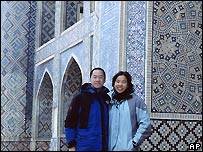 Until now, the
conventional view was that the complicated
star-and-polygon patterns of Islamic design were
conceived as zigzagging lines drafted using
straightedge rulers and compasses. "You can
go through and see the evolution of increasing
geometric sophistication. So they start out with
simple patterns, and they get more complex,"
Mr Lu added. Until now, the
conventional view was that the complicated
star-and-polygon patterns of Islamic design were
conceived as zigzagging lines drafted using
straightedge rulers and compasses. "You can
go through and see the evolution of increasing
geometric sophistication. So they start out with
simple patterns, and they get more complex,"
Mr Lu added.
He
became interested in the subject while travelling
in Uzbekistan, where he noticed a 16th Century
Islamic building with decagonal motif tiling. Mr
Lu, who designs physics experiments for the
International Space Station, was in the region in
order to visit a space facility in Turkmenistan.
Islamic art traditionally uses a mixture of
calligraphy, geometric and floral designs because
of a prohibition on the portrayal of the human
form.BBC World News
************
The most
sought-after artefacts tend to be the oldest.
Those looking for the purest examples of Islamic
art might be expected to look to the formative
years of the religion. Its development was indeed
remarkable. Back in the 1920s, when frank
discussion of non-European cultures was more
common than it is now, the authoritative A.H.
Christie wrote: “When Islam began that
dramatic career which, in its Western course, was
destined to plant a new form of art in cities
overlooking the Atlantic, it set out from regions
where art was in a primitive and backward
state.”
This was indeed a time of great change. Within a
century, Islam had created an artistic model that
remained the envy of Europe until the
Renaissance. Some of its earliest manifestations
are distressing, and not because they are
struggling to free themselves from a
“primitive and backward state”. They
are simply not “Islamic” in any way
that would be expected of a new world order. The
desert hunting lodges of certain rulers of the
Umayyad dynasty (661–750) suggest a
lifestyle closer to the emperor Caligula than the
Rightly Guided Caliphs. Semi-clothed dancing
girls cavort on frescoes amid references to hard
drinking. Al-Walid II was one of the least
inspiring role models for those hoping to find
the Message in these remote and rather haunting
palaces. He was unrepentant in his addiction to
pleasure. “Let the paradise seekers plod on
to perdition” is one quote attributed to
this dissolute ruler.
Regardless of the disappointments presented by
these Umayyad struc-tures, the key to Islamic art
lies in architecture. Instead of secular
build-ings, it was the mosque that became one of
Islam’s most lasting gifts to man-kind. Its
greatness cannot be denied. This is creative
endeavour put to the service of the Umma, and to
the glorification of God. No one could deny that
it is both Islamic and art. It can also be shared
by almost anyone. This is in contrast to the sort
of art that collectors pursue.
Islamic art as it exists now is considerably less
public than it was before it was considered to be
“art”. Whilst no collectors have yet
transported entire mosques to the privacy of
their gated communities, in the way that London
Bridge was moved to the Arizona desert, little
bits of the original buildings have become
important collectables. Ceramics tiles are the
most likely fixtures to end up in the auction
room. Older mosques now need as much vigilance as
older churches. The field of Islamic-art dealing
is filled with as many dubious practices as the
art of the classical world. Fortu-nately, museums
these days are more rigorous in their vetting
procedures than they used to be.
For more portable objects, museums and other
collectors have provided a sanctuary against
turbulent times. The Taliban are known to have
deliberately destroyed considerably more than the
giant Buddhas of Bamiyan. Their actions also
dealt a blow to much that would be considered
genuinely Islamic. Negligence and incompetence
were to blame for a lot of the losses in
Afghanistan. Similarly, American activity in
Baghdad probably saw the end of manuscripts of
incalculable value while the world watched events
taking place at another building in horror. It
was mainly Iraq’s pre-Islamic culture that
was pillaged in the early days of the US
invasion, leading to claims that 170,000 objects
had gone missing. This total came down to about
one thousandth of the original estimate. While
the international community raged against the
loss of these mainly pre-Islamic artefacts, less
attention was paid to the more considerable
devasta-tion of mostly Islamic manuscripts at the
National Library.
It is the written word that comes closest to the
mosque as a manifestation of Islamic art. There
can be no denying that a copy of the Qur’an
is Islamic, although it could be argued that it
is not “art”. Being the literal word of
God places it at a higher level than that. From
the collector’s point of view, this is the
purest form of the art. It is incontrovertibly
sacred and at the same time universally
considered beautiful. Beauty is not a topic
tackled in detail by the Qur’an itself. The
closest association is the commonly quoted
hadith, “God is beautiful, and He loves
beauty.” If it is assumed that beauty is
integral to art -- as was assumed by most
societies until the 20th century -- then
Qur’anic calligraphy is acceptable to all
but the most prejudiced.
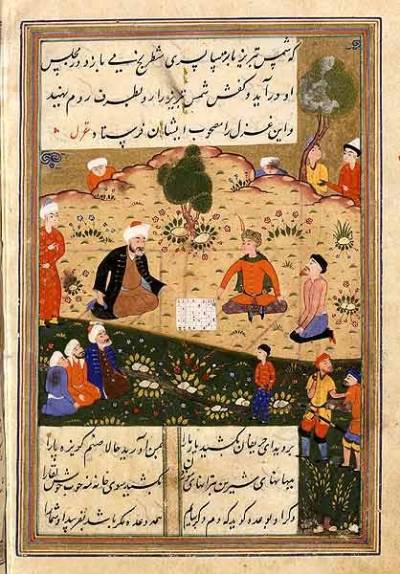 Although considered a
“minor” or “decorative” art
by most early histo-rians of Islamic art,
manuscripts are now ranked among Islam’s
most sublime achievements. The original
evaluation is not surprising, since the pioneers
of Islamic art analysis were non-Muslims. Among
Muslims, it had not seemed important to examine
fields such as calligraphy in terms of art. While
China and Europe have had their own art critics
for centuries, the same was not true of Islam.
Even without this self-conscious form of
assessment, the scribe was accorded the highest
status of any artisan in the Islamic world. Although considered a
“minor” or “decorative” art
by most early histo-rians of Islamic art,
manuscripts are now ranked among Islam’s
most sublime achievements. The original
evaluation is not surprising, since the pioneers
of Islamic art analysis were non-Muslims. Among
Muslims, it had not seemed important to examine
fields such as calligraphy in terms of art. While
China and Europe have had their own art critics
for centuries, the same was not true of Islam.
Even without this self-conscious form of
assessment, the scribe was accorded the highest
status of any artisan in the Islamic world.
Nor was it beneath Muslim rulers to demonstrate
their calligraphic pro-wess, which was by no
means a tradition for Christian monarchs.
Copies of the Qur’an can go further than
being works of calligraphy. Later versions are
often so elaborate, it is hard to see the words
at all. This goes against the spirit of the early
Qur’ans, which are stunning examples of
minimalist power. The oldest extant examples are
from the 8th century, although some conspiracy
theorists insist that earlier copies
exist—–or did until the US military
forces in Iraq supposedly eliminated them. These
formative works feature plain Kufic script on
vellum. Simple though they may seem, the way that
ink and space are combined transforms them into
masterpieces. The austerity and sense of mission
that existed in early Islam are summed up
perfectly in these works.
The absence of a “fine art” tradition
in Islam puts early Qur’ans at the same
level of importance as the sculptures of
antiquity or Renaissance paintings. In all other
respects they are different. Not least is the
anonymity of these transcriptions of God’s
word when compared with the near-celebrity status
of Christian and pre-Christian artists.
As Western art historians have long been
determined that any culture of interest should
have its own forms of “art”, they have
had to include many categories of Islamic
creativity that in Western terms would seem
folksy. Islam has seldom placed much value on
“art” to hang on the wall, and
sculpture was an even lower priority. The
“minor” arts that were referred to in
the 19th and early 20th centuries have now become
major. It is not just the auction houses that
would have chess pieces and scientific
instruments elevated to the global hall of art
fame. The more the glories of Islamic culture are
examined, the more natural it seems to put
sometimes prosaic-sounding items on a pedestal.
One of the most significant objects in Islamic
art has the unpromising name of the
“Bobrinsky bucket”. This bronze,
cauldron-like vessel from 12th century Herat is
indeed a bucket, but with its exquisite
decoration, it is also evidence of a society that
was able to transform the mundane into the
magnificent.
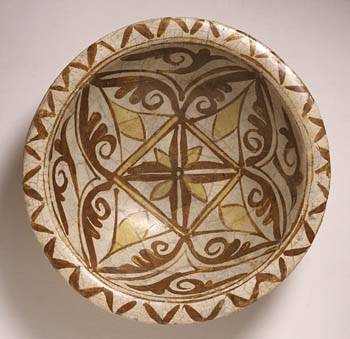 Most of the artefacts
that are classified as Islamic art had an
original purpose that would now seem humble.
Bronze vessels and other utilitarian items
clearly had a greater meaning to their owners
than a pewter dish or tankard had in Europe.
Similarly, the ceramics of the Islamic world were
far from being the Tupperware of their time.
Whatever the medium, they were likely to have
inscriptions, and in most cases these would have
religious significance. The simple beauty of the
Arabic alphabet is as apparent on a 12th-century
earthenware bowl as it is in a Qur’an
commissioned by a ruler. Most of the artefacts
that are classified as Islamic art had an
original purpose that would now seem humble.
Bronze vessels and other utilitarian items
clearly had a greater meaning to their owners
than a pewter dish or tankard had in Europe.
Similarly, the ceramics of the Islamic world were
far from being the Tupperware of their time.
Whatever the medium, they were likely to have
inscriptions, and in most cases these would have
religious significance. The simple beauty of the
Arabic alphabet is as apparent on a 12th-century
earthenware bowl as it is in a Qur’an
commissioned by a ruler.
In Islam, art was all-embracing. It may not have
been called art by those who made or used it, but
there was an understanding that any object could
an expression of God’s presence in a
believer’s life, whether or not it expressed
a central tenet such as the oneness of God.
Taking pride in crea-tivity went hand in hand
with the application of ideas of technology. The
great eras of Islamic artistic expression
coincided with times of technological progress.
Muslims are forever being exhorted to remember
that theirs was once the culture of progress, the
transmitter of ancient knowledge to the modern
world. Ideas were an inspiration to more than
just philosophers and mathematicians. By looking
at Islamic art, it becomes apparent that the
whole of society was part of something important.
The prices paid for these objects now shows that
their quality is appreciated.
It is only the past that generates this
excitement. Just as the most sought-after Islamic
art is from times when Islam was a powerful force
in the world, there is little from contemporary
Muslim artists that sets paddles waving in the
saleroom. There are also some types of older
artefacts that create the same apathy. These
include objects that both the market and art
historians leave out for no apparent reason other
than their geographical origins. A prominent
example is the Islamic art of Southeast Asia,
which is excluded from almost every academic
survey of Islamic art. The reasons 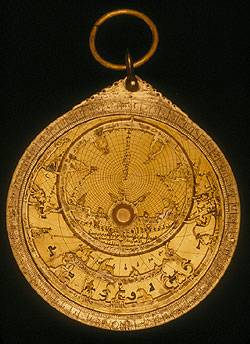 are far from obvious, as works from the
Malay world include magnificent textiles,
manuscripts and metalwork that were produced by
Muslims for Muslims, serving an Islamic purpose.
They feature Qur’anic invocations and other
elements that should have museums around the
world clamouring for them. They remain ignored,
although this might be rectified by a pioneering
exhibition at the Islamic Arts Museum Malaysia
later this year. are far from obvious, as works from the
Malay world include magnificent textiles,
manuscripts and metalwork that were produced by
Muslims for Muslims, serving an Islamic purpose.
They feature Qur’anic invocations and other
elements that should have museums around the
world clamouring for them. They remain ignored,
although this might be rectified by a pioneering
exhibition at the Islamic Arts Museum Malaysia
later this year.
It seems that a double standard exists. The world
accepts that Islamic art does exist, and there is
a surprising amount of common ground between
scholars and the marketplace on what this
consists of. At the same time, an almost
identical object is somehow seen as being less
valid when it comes from a place that is not the
original Islamic heartland. Muslims in general
take as little interest as everyone else in the
magnificent work of the Umma on the southeast
frontier of Islam. Does this suggest that an
interest in Islamic art has little to do with
admiration for the universal religion and more to
do with collecting national treasures, especially
when they come from Turkey, Iran and the Arab
world?
[About the Author]
Lucien de Guise is the Acting Head Curator of the
Islamic Arts Museum Malaysia. After completing
his MA in Islamic Studies, Lucien de Guise worked
as the deputy editor of Arts of Asia magazine.
Since then he has specialised in Oriental art and
writes a monthly column for eight publica-tions
in Asia. In addition to contributing to magazines
in the UK and USA, he has written the only guide
to collectibles in Malaysia.
Copyright 2007 Islamica Magazine.
All rights reserved.
|

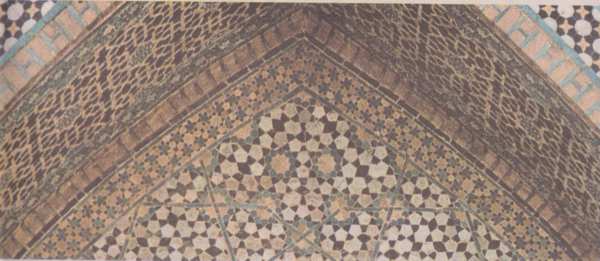

 centuries later
by modern mathematicians. Researchers in the US
have found 15th Century examples that use the
concept of quasicrystalline geometry. This
indicates intuitive understanding of complex
mathematical formulae, even if the artisans had
not worked out the underlying theory, the study
says.
centuries later
by modern mathematicians. Researchers in the US
have found 15th Century examples that use the
concept of quasicrystalline geometry. This
indicates intuitive understanding of complex
mathematical formulae, even if the artisans had
not worked out the underlying theory, the study
says.  Until now, the
conventional view was that the complicated
star-and-polygon patterns of Islamic design were
conceived as zigzagging lines drafted using
straightedge rulers and compasses. "You can
go through and see the evolution of increasing
geometric sophistication. So they start out with
simple patterns, and they get more complex,"
Mr Lu added.
Until now, the
conventional view was that the complicated
star-and-polygon patterns of Islamic design were
conceived as zigzagging lines drafted using
straightedge rulers and compasses. "You can
go through and see the evolution of increasing
geometric sophistication. So they start out with
simple patterns, and they get more complex,"
Mr Lu added.  Although considered a
“minor” or “decorative” art
by most early histo-rians of Islamic art,
manuscripts are now ranked among Islam’s
most sublime achievements. The original
evaluation is not surprising, since the pioneers
of Islamic art analysis were non-Muslims. Among
Muslims, it had not seemed important to examine
fields such as calligraphy in terms of art. While
China and Europe have had their own art critics
for centuries, the same was not true of Islam.
Even without this self-conscious form of
assessment, the scribe was accorded the highest
status of any artisan in the Islamic world.
Although considered a
“minor” or “decorative” art
by most early histo-rians of Islamic art,
manuscripts are now ranked among Islam’s
most sublime achievements. The original
evaluation is not surprising, since the pioneers
of Islamic art analysis were non-Muslims. Among
Muslims, it had not seemed important to examine
fields such as calligraphy in terms of art. While
China and Europe have had their own art critics
for centuries, the same was not true of Islam.
Even without this self-conscious form of
assessment, the scribe was accorded the highest
status of any artisan in the Islamic world.  Most of the artefacts
that are classified as Islamic art had an
original purpose that would now seem humble.
Bronze vessels and other utilitarian items
clearly had a greater meaning to their owners
than a pewter dish or tankard had in Europe.
Similarly, the ceramics of the Islamic world were
far from being the Tupperware of their time.
Whatever the medium, they were likely to have
inscriptions, and in most cases these would have
religious significance. The simple beauty of the
Arabic alphabet is as apparent on a 12th-century
earthenware bowl as it is in a Qur’an
commissioned by a ruler.
Most of the artefacts
that are classified as Islamic art had an
original purpose that would now seem humble.
Bronze vessels and other utilitarian items
clearly had a greater meaning to their owners
than a pewter dish or tankard had in Europe.
Similarly, the ceramics of the Islamic world were
far from being the Tupperware of their time.
Whatever the medium, they were likely to have
inscriptions, and in most cases these would have
religious significance. The simple beauty of the
Arabic alphabet is as apparent on a 12th-century
earthenware bowl as it is in a Qur’an
commissioned by a ruler. are far from obvious, as works from the
Malay world include magnificent textiles,
manuscripts and metalwork that were produced by
Muslims for Muslims, serving an Islamic purpose.
They feature Qur’anic invocations and other
elements that should have museums around the
world clamouring for them. They remain ignored,
although this might be rectified by a pioneering
exhibition at the Islamic Arts Museum Malaysia
later this year.
are far from obvious, as works from the
Malay world include magnificent textiles,
manuscripts and metalwork that were produced by
Muslims for Muslims, serving an Islamic purpose.
They feature Qur’anic invocations and other
elements that should have museums around the
world clamouring for them. They remain ignored,
although this might be rectified by a pioneering
exhibition at the Islamic Arts Museum Malaysia
later this year.